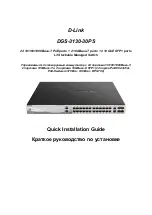
5000 Series Layer 2/3 Managed Data Center Switch CLI Reference Guide
896
•
Attempt – no recent information has been received from the
neighbor but a more concerted effort should be made to contact
the neighbor.
•
lnit – an Hello packet has recently been seen from the neighbor,
but bidirectional communication has not yet been established.
•
2 way – communication between the two routers is bidirectional.
•
Exchange start – the first step in creating an adjacency between
the two neighboring routers, the goal is to decide which router is
the master and to decide upon the initial Database Description
(DD) sequence number.
•
Exchange – the router is describing its entire link state database
by sending DD packets to the neighbor.
•
Full – the neighboring routers are fully adjacent and they will
now appear in router-LSAs and network-LSAs.
Dead Time
The amount of time, in seconds, to wait before the router assumes the
neighbor is unreachable.
Restart Helper Status
Indicates the status of this router as a helper during a graceful restart of
the router specified in the command line:
•
Helping – This router is acting as a helpful neighbor to the
specified router.
•
Not Helping – This router is not a helpful neighbor at this time.
Restart Reason
When this router is in helpful neighbor mode, this indicates the reason
for the restart as provided by the restarting router.
Remaining Grace Time
The number of seconds remaining in current graceful restart interval.
This is displayed only when this router is currently acting as a helpful
neighbor for the router specified in the command.
Restart Helper Exit Reason
Indicates the reason that the specified router last exited a graceful
restart.
•
None – Graceful restart has not been attempted
•
in Progress – Restart is in progress
•
Completed – The previous graceful restart completed
successfully
•
Timed Out – The previous graceful restart timed out
•
Topology Changed – The previous graceful restart terminated
prematurely because of a topology change.
If you specify an IP address for the neighbor router, the following fields display:
Interface
The interface of the local router.
Area ID
The area ID associated with the interface.
Options
An integer value that indicates the optional OSPF capabilities supported
by the neighbor. These are listed in its Hello packets. This enables
received Hello Packets to be rejected (i.e., neighbor relationships will
not even start to form) if there is a mismatch in certain crucial OSPF
capabilities.
Router Priority
The router priority for the specified interface.
Dead Timer Due
The amount of time, in seconds, to wait before the router assumes the
















































